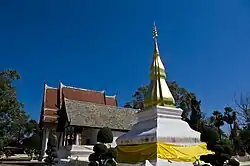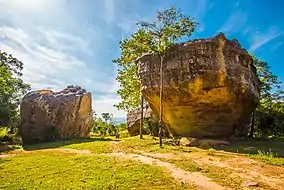Khon Kaen province
Khon Kaen (Thai: ขอนแก่น, pronounced [kʰɔ̌(ː)n kɛ̀n]) is one of Thailand's 76 provinces (changwat). It is in central northeastern Thailand. Neighboring provinces are (from north, clockwise) Nong Bua Lamphu, Udon Thani, Kalasin, Maha Sarakham, Buriram, Nakhon Ratchasima, Chaiyaphum, Phetchabun, and Loei.
Khon Kaen
ขอนแก่น | |
|---|---|
From left to right, top to bottom : Phra That Kham Kaen, Nam Phong National Park, Ubol Ratana Dam, Phra Mahathat Kaen Nakhon, Khon Kaen City Pillar Shrine, Khon Kaen University | |
 Flag  Seal | |
 Map of Thailand highlighting Khon Kaen province | |
| Country | Thailand |
| Capital | Khon Kaen |
| Government | |
| • Governor | Kraison Thongchalart |
| Area | |
| • Total | 10,659 km2 (4,115 sq mi) |
| • Rank | Ranked 14th |
| Population (2019)[2] | |
| • Total | 1,802,872 |
| • Rank | Ranked 4th |
| • Density | 169/km2 (440/sq mi) |
| • Rank | Ranked 19th |
| Human Achievement Index | |
| • HAI (2017) | 0.6090 "somewhat high" Ranked 24th |
| Time zone | UTC+7 (ICT) |
| Postal code | 40xxx |
| Calling code | 043 |
| ISO 3166 code | TH-40 |
| Vehicle registration | ขอนแก่น |
| Website | www |
History
Several bronze and iron tools used as axes have been discovered in the province, along with a bronze ring attached to a skeleton. This is in addition to a copper axe found from 4,600 to 4,800 (2600 BC to 2800 BC), the oldest in Southeast Asia.[4] During the Dvaravati period, Khon Kaen was influenced by the culture of the central region. The oldest inscription found in Khon Kaen dates back to the 8th century and is written in the Old Mon language, suggesting the presence of Mon people in the area at that time.[5]: 93 The Dvaravati culture is believed to have played a significant role in the region, and the Nyah Kur people are thought to be descendants of the Dvaravati Mon people.[5]: 75 During the 10th-11th centuries and onwards, the area came under Khmer influence, as evidenced by various inscriptions.[5]: 166 The area fell into the control of Lan Xang before coming under Central Thai control.[6]
The first city of the area was established in 1783 when Rajakruluang settled there with 330 people. King Rama I made Rajakruluang the first governor of the area when establishing tighter connections with the Isan area. The main city was moved six times until in 1879 it reached its present-day location at Nuang Kaw. Khon Kaen was under the governance of Udon in the early period of Rattanakosin, c. 2450 BCE. The Integrated Opisthorchiasis Control Program, also known as the Lawa Project, an internationally recognized liver fluke control program, has its offices in the Ban Phai and Ban Haet Districts south of Khon Kaen city.
Other satellite cities that has to do with the separation from the city of Suwannabhumi and later separated into a city in the province of Khon Kaen after 1797 that includes the city of Mancha Khiri district.
Khon Kaen was incorporated as a city in 1797.
Geography
Khon Kaen occupies part of the Khorat Plateau. The Chi and Phong Rivers flow through the province. The total forest area is 1,222 km2 (472 sq mi) or 11.5 percent of provincial area.[1]
National parks
There are four national parks, three of which along with three other national parks make up region 8 (Khon Kaen), and Phu Kao–Phu Phan Kham in region 10 (Udon Thani) of Thailand's protected areas.
- Phu Pha Man National Park, 350 km2 (140 sq mi)[7]: 72
- Phu Wiang National Park, 325 km2 (125 sq mi)[7]: 71
- Phu Kao–Phu Phan Kham National Park, 318 km2 (123 sq mi)[7]: 50
- Nam Phong National Park, 197 km2 (76 sq mi)[7]: 100
Symbols
| The seal of the province shows the stupa (tower) of Phra That Kham Kaen, which is believed to contain relics of Buddha. A tree is depicted on each side. One is a banyan tree (Ficus benghalensis), the other a Golden Shower Tree (Cassia fistula). The Thai name of the golden shower means 'providing support and preventing a decline', and it is also the provincial flower. The provincial tree is the pink shower tree (Cassia bakeriana), the Thai name of which translates as 'wishing tree'. |
Culture
Sinxay
The mayor of Khon Kaen in 2005 chose Sinxay to be the new identity of the Khon Kaen and had finials designed representing Sinxay and his two brothers, Siho and Sangthong. The story of Sang Sinxay, one of the masterpieces of Lao literature written by Pang Kham in 1649, during the Lan Xang period.[8]
Administrative divisions
Provincial government

The province is divided into 26 districts (amphoes). The districts are further divided into 198 subdistricts (tambons) and 2,139 villages (mubans).
- The numbers 26 to 28 were reserved for three other planned (minor) districts: Phu Kham Noi, Nong Kae, and Non Han.
There are plans to split off the northwestern part of the province to form a new province centered at Phu Wiang. The other districts which will belong to this new province are Nong Ruea, Chum Phae, Si Chomphu, Phu Pha Man, Nong Na Kham, and Wiang Kao.[9]
Local government
As of 26 November 2019 there are:[10] one Khon Kaen Provincial Administration Organisation (ongkan borihan suan changwat) and 84 municipal (thesaban) areas in the province. Khon Kaen has city (thesaban nakhon) status. Ban Phai, Ban Thum, Chum Phae, Kranuan, Mueang Phon and Sila have town (thesaban mueang) status. Further 77 subdistrict municipalities (thesaban tambon). The non-municipal areas are administered by 140 Subdistrict Administrative Organisations - SAO (ongkan borihan suan tambon).[2]
Education
- Universities
- Schools
Health
Khon Kaen has hospitals operated by both the public and private sectors. Its main hospital operated by the Ministry of Public Health is Khon Kaen Hospital. The province also has a university hospital, Srinagarind Hospital of the Faculty of Medicine, Khon Kaen University.
Transport
- Air
.jpg.webp)
- Rail
The railway system in Khon Kaen is on both northeastern routes from Bangkok Railway Station. Khon Kaen province's main railway stations was Khon Kaen Railway Station. In 2017, a 60 kilometre dual-track line will connect Khon Kaen to Nakhon Ratchasima province. It is the first segment of a dual track network that will connect Isan with the Laem Chabang seaport.[11]
- Road
The city is bisected by Mittraphap Road, also known as "Friendship Highway", or Asian Highway 2 (AH2), the road linking Bangkok to the Thai-Lao Friendship Bridge. A multi-lane bypass enables through-traffic to avoid the city center to the west, and connects to the airport and to the main roads to Kalasin province and Maha Sarakham province in the east, and Udon Thani province in the north.
Sport
The sports teams listed below are based in Khon Kaen.
- Football
- Khon Kaen (Thai League 2)—Khon Kaen Provincial Stadium
- Khon Kaen United (Thai League 2)—Khon Kaen Provincial Stadium
- Volleyball
- Khonkaen Star (Women's Volleyball Thailand League)—Khonkaen International Convention and Exhibition Center
Human achievement index 2017
| Health | Education | Employment | Income |
| 37 | 34 | 32 | 51 |
| Housing | Family | Transport | Participation |
 |
 |
 |
|
| 50 | 3 | 21 | 52 |
| Province Khon Kaen, with an HAI 2017 value of 0.6090 is "somewhat high", occupies place 24 in the ranking. | |||
Since 2003, United Nations Development Programme (UNDP) in Thailand has tracked progress on human development at sub-national level using the Human achievement index (HAI), a composite index covering all eight key areas of human development. National Economic and Social Development Board (NESDB) has taken over this task since 2017.[3]
| Rank | Classification |
| 1 - 15 | "high" |
| 16 - 30 | "somewhat high" |
| 31 - 45 | "average" |
| 45 - 60 | "somewhat low" |
| 61 - 77 | "low" |
| Map with provinces and HAI 2017 rankings |
 |
Notable residents
- Paradorn Srichaphan, tennis player, the first Asian to reach top ten of the ATP rankings
- Somluck Kamsing, boxer, the first Thai athlete to win a gold medal at the Olympics
- Nadech Kugimiya, actor
- Sukollawat Kanarot, actor
- Peechaya Wattanamontree, actress
- Apichatpong Weerasethakul, filmmaker
- Kanphanitnan Muangkhumsakul, professional golfer (LPGA Tour)
Gallery
References
- "ตารางที่ 2 พี้นที่ป่าไม้ แยกรายจังหวัด พ.ศ.2562" [Table 2 Forest area Separate province year 2019]. Royal Forest Department (in Thai). 2019. Retrieved 6 April 2021, information, Forest statistics Year 2019, Thailand boundary from Department of Provincial Administration in 2013
{{cite web}}: CS1 maint: postscript (link) - รายงานสถิติจำนวนประชากรและบ้านประจำปี พ.ส.2562 [Statistics, population and house statistics for the year 2019]. Registration Office Department of the Interior, Ministry of the Interior. stat.bora.dopa.go.th (in Thai). 31 December 2019. Archived from the original on 14 June 2019. Retrieved 26 February 2020.
- Human achievement index 2017 by National Economic and Social Development Board (NESDB), pages 1-40, maps 1-9, retrieved 14 September 2019, ISBN 978-974-9769-33-1
- "ประวัติจังหวัขอนแก่น". 2021-05-17. Archived from the original on 2021-05-17. Retrieved 2023-04-12.
- Stephen A. Murphy (September 2010), Buddhist Boundary Markers of Northeast Thailand and Central Laos, 7th-12th Centuries CE: Towards an Understanding of the Archaeological, Religious, and Artistic Landscapes of the Khorat Plateau (PDF), University of London
- "จังหวัดขอนแก่น ประวัติศาสตร์ ความเป็นมา". www.baanjomyut.com. Retrieved 2023-04-12.
- "ข้อมูลพื้นที่อุทยานแห่งชาติ ที่ประกาศในราชกิจจานุบกษา 133 แห่ง" [National Park Area Information published in the 133 Government Gazettes]. Department of National Parks, Wildlife and Plant Conservation (in Thai). December 2020. Retrieved 1 November 2022.
- "ฐานที่มั่นทางวัฒนธรรมของชาวลาวอีสาน-4-5600-107946-1.html "สินไซ - "ฐานที่มั่นทางวัฒนธรรม" ของชาวลาว-อีสาน".
- "ที่เที่ยวขอนแก่น -10 เที่ยวหลากสไตล์ ท่องไปในขอนแก่น".
- "Number of local government organizations by province". dla.go.th. Department of Local Administration (DLA). 26 November 2019. Retrieved 10 December 2019.
5 Khon Kaen: 1 PAO, 1 City mun., 6 Town mun., 77 Subdistrict mun., 140 SAO.
- Janssen, Peter (2 November 2016). "Thailand takes a long-term gamble on Isaan region". Nikkei Asian Review. Retrieved 3 November 2016.
External links
 Khon Kaen travel guide from Wikivoyage
Khon Kaen travel guide from Wikivoyage- Province page from the Tourist Authority of Thailand
- Official website of province (Thai only)




.jpg.webp)




